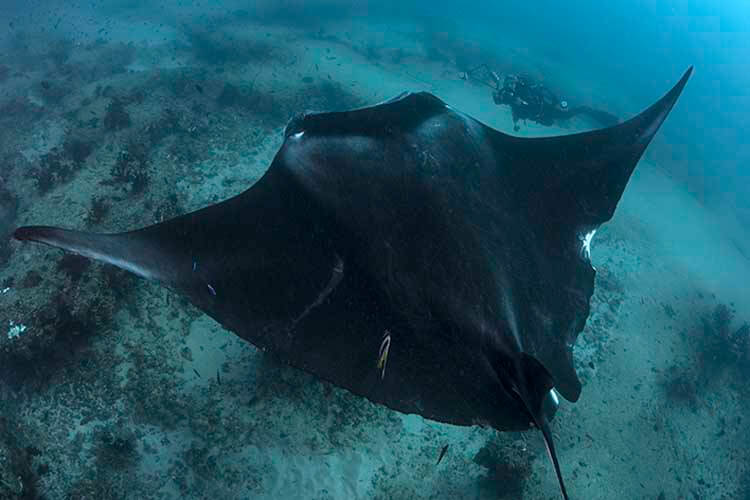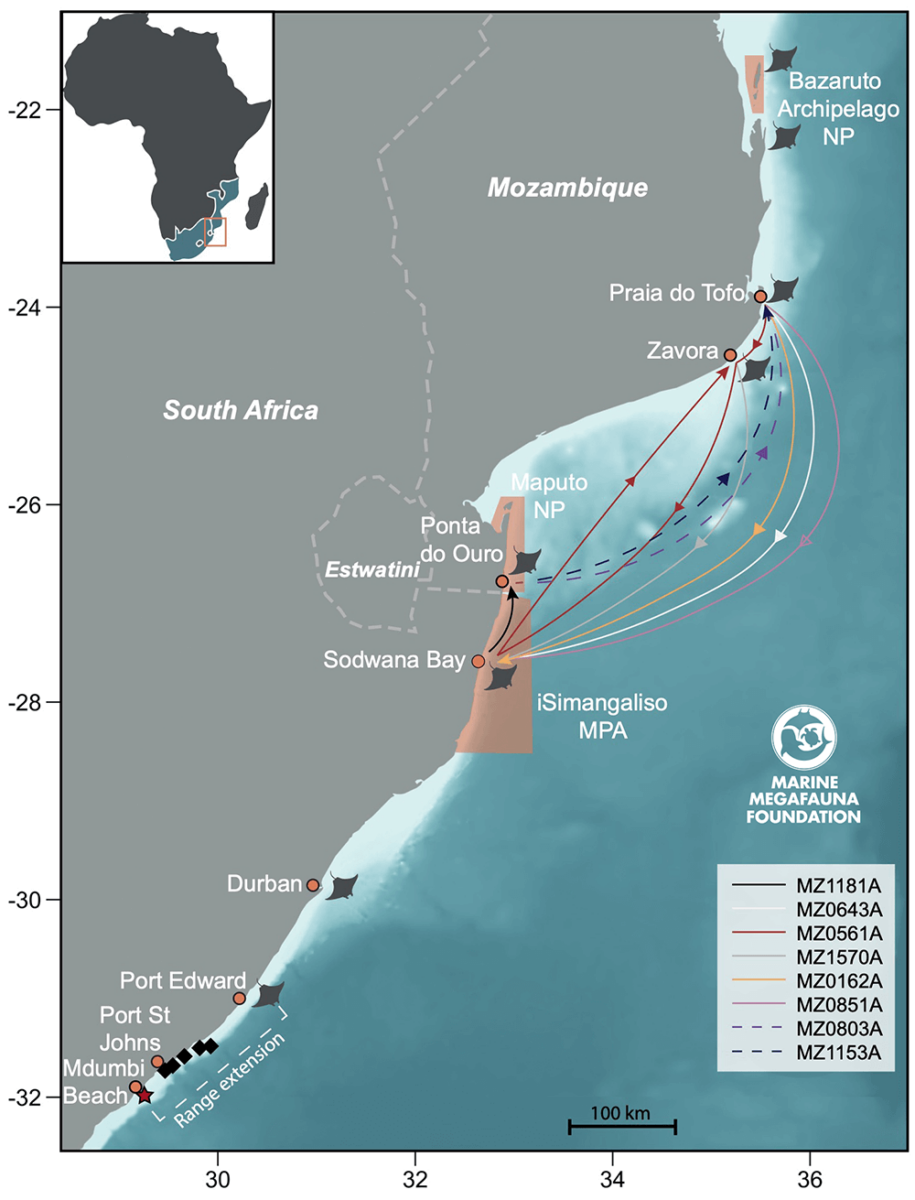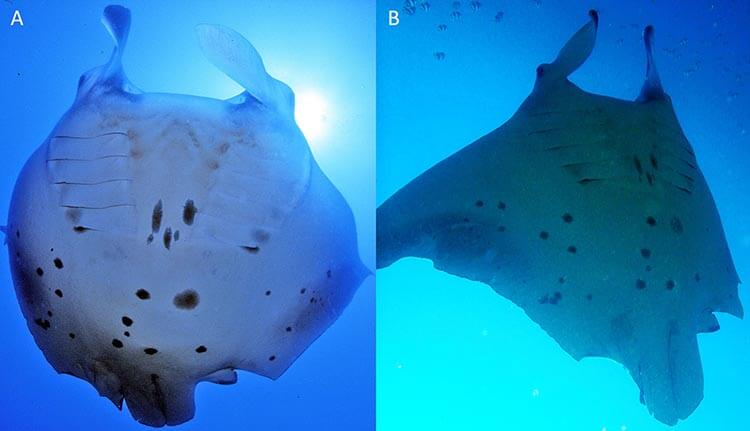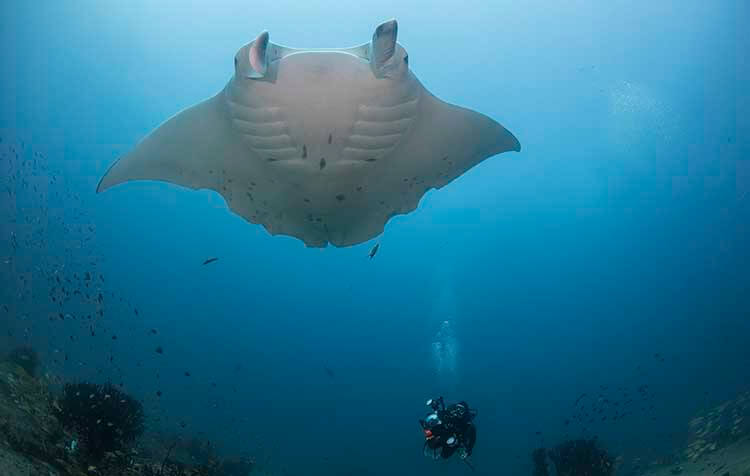
New research by the Marine Megafauna Foundation has extended the southern range of the reef manta ray (Mobula alfredi) in Africa, connecting the longest monitored and highly vulnerable population of reef manta rays in southern Mozambique to the UNESCO World Heritage site of iSimangaliso in South Africa.
Citizen science contributions combined with fieldwork in South Africa have extended the reef mantas’ southern range by approximately 140 km to Mdumbi Beach, and have provided the first confirmed international movement records for the species.
The longest (one-way) movement captured during the study was an individual which travelled between Tofo Beach, Mozambique and Sodwana Bay, South Africa in less than 301 days – a straight-line distance of 505 km. Another manta made a return trip between Zavora in Southern Mozambique and Sodwana Bay, a total distance of at least 870 km.
The study highlights gaps in the existing knowledge of the species, and scientists hope that it will encourage more focused research on manta rays along the eastern coast of Africa.

‘As highly mobile species, reef manta rays are capable of long-range movements, so it was only a matter of time until we documented international exchange between the waters of adjacent countries,’ said Dr Andrea Marshall, MMF co-founder and principal scientist. ‘We are thrilled to have finally confirmed this for the first time through rigorous, long-term research efforts along the southeastern coast of Africa.’
MMF’s manta ray research program in Mozambique has been monitoring the southern Mozambican population for more than 20 years, making it one of the longest and most comprehensive manta ray studies globally.
The Foundation’s previous work has found a steep decline in manta ray sightings over the past two decades, highlighting it as an at-risk population. A critical part of the team’s research focus is to understand better where and how far the species moves in order to guide effective management solutions.
MMF scientist Dr Stephanie Venables, who completed her PhD thesis on the Mozambican manta ray population, said that the cross-border movements ‘are an important finding, as they demonstrate the need for cooperative species management between the neighbouring countries.’

Citizen science played a significant role in the study, with the SCUBA diving community submitting ID photos of mantas in South Africa to MantaMatcher.org, the global online open-access database for ray sightings. Cross-referencing regional databases using automated pattern-matching algorithms led to confirmation of the African manta rays’ extended range.
‘Citizen science contributions were critical to this research,’ said Anna Flam, global manager of Manta Matcher. ‘The first two transboundary movements were detected with public submissions to Manta Matcher, showing how people everywhere can contribute to conservation science.’
Nakia Cullain, a PhD student at Dalhousie University and manager of MMF’s southernmost field station for manta rays at Zavora, said she was ‘not surprised’ to learn of the rays’ connectivity to South Africa. ‘Seasonality of mantas at Zavora and limited connectivity to Tofo has always suggested southern movements,’ said Cullain. ‘Although we are just beginning to brush the surface of these movements, these findings are a huge step forward in helping us to inform the management and conservation of the species within southern Africa.’

‘South Africa has been a missing piece of the puzzle for some time, and there is still a lot of work needed to understand manta ray habitat use here,’ said Michelle Carpenter, a PhD candidate at the University of Cape Town, who began managing South Africa’s manta ray photo-ID database in 2020. ‘At first it was overwhelming to narrow down hotspots and build up a photo ID database along such a large coastline, but citizen science support has been instrumental to the process. It is a great example of how public contributions can directly support research.’
MMF has been instrumental in gaining protection for manta rays, having previously worked with the Ecuadorian government to add giant oceanic manta rays (Mobula birostris) to the Convention of Migratory Species (CMS) in 2011, and reef mantas in 2014.
‘We are pleased that our research efforts continue to produce data that can be used for the ongoing conservation and management of manta ray species,’ said Dr Marshall, ‘particularly off southern Africa where populations are under significant threat.’
This article has been edited from the original version, as published on the MMF website. The complete study, entitled ‘Southward range extension and transboundary movements of reef manta rays Mobula alfredi along the east African coastline’ by Andrea Marshall et al is published in the Journal of Fish Biolog, December 2022. Learn more about MMF and its work by following the team on Twitter, Facebook, Instagram, and LinkedIn.


